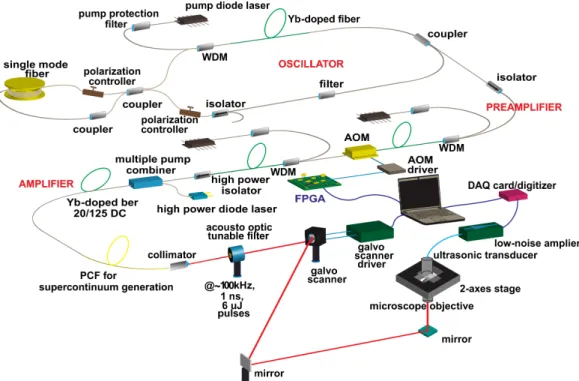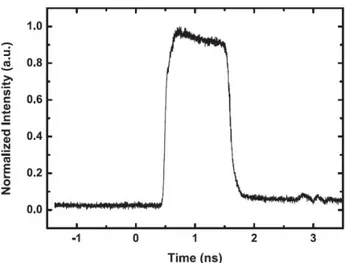A novel fiber laser development for photoacoustic microscopy
Seydi Yavas
a, Esra Aytac-Kipergil
b, Mustafa U. Arabul
c, Hakan Erkol
b, Onder Akcaalan
a,
Y. Burak Eldeniz
eF. Omer Ilday
aand Mehmet B. Unlu
b,da
Department of Physics, Bilkent University, Bilkent, 06800, Ankara, Turkey;
b
Department of Physics, Bogazici University, Bebek, 34342, Istanbul, Turkey;
c
Institute of Biomedical Engineering, Bogazici University, Kandilli, 34684, Istanbul, Turkey;
d
Center for Life Sciences and Technologies, Bogazici University, Kandilli, 34342, Istanbul,
Turkey
e
Department of Electrical and Electronics Engineering, Ankara University, Tandogan, 06100,
Ankara, Turkey
ABSTRACT
Photoacoustic microscopy, as an imaging modality, has shown promising results in imaging angiogenesis and cutaneous malignancies like melanoma, revealing systemic diseases including diabetes, hypertension, tracing drug efficiency and assessment of therapy, monitoring healing processes such as wound cicatrization, brain imaging and mapping. Clinically, photoacoustic microscopy is emerging as a capable diagnostic tool. Parameters of lasers used in photoacoustic microscopy, particularly, pulse duration, energy, pulse repetition frequency, and pulse-to-pulse stability affect signal amplitude and quality, data acquisition speed and indirectly, spatial resolution. Lasers used in photoacoustic microscopy are typically Q-switched lasers, low-power laser diodes, and recently, fiber lasers. Significantly, the key parameters cannot be adjusted independently of each other, whereas microvasculature and cellular imaging, e.g., have different requirements. Here, we report an integrated fiber laser system producing nanosecond pulses, covering the spectrum from 600 nm to 1100 nm, developed specifically for photoacoustic excitation. The system comprises of Yb-doped fiber oscillator and amplifier, an acousto-optic modulator and a photonic-crystal fiber to generate supercontinuum. Complete control over the pulse train, including generation of non-uniform pulse trains, is achieved via the AOM through custom-developed field-programmable gate-array electronics. The system is unique in that all the important parameters are adjustable: pulse duration in the range of 1-3 ns, pulse energy up to 10 µJ, repetition rate from 50 kHz to 3 MHz. Different photocoustic imaging probes can be excited with the ultrabroad spectrum. The entire system is fiber-integrated; guided-beam-propagation rendersit misalignment free and largely immune to mechanical perturbations. The laser is robust, low-cost and built using readily available components.
Keywords: Photoacoustic imaging, fiber laser, mode-locked, supercontinuum, photonic crystal fiber
1. INTRODUCTION
Pulsed lasers have critical effects on quality of photoacoustic imaging, especially for life science applications. In particular, pulsed lasers with durations range from 1 ns to 50 ns are used for photoacoustic imaging systems. Nanosecond pulses mostly rely on Q-switched lasers, whereas, some may be generated by directly modulated diode lasers. Yet, their pulse repetition frequency (PRF) are on the order of Hz and rarely on the order of kHz. Beyond MHz region is harder to be approached for Q-switch and modulated diode lasers.
In literature, Wang et al. used 1064 nm fiber laser with 10 ns pulse width and 50 kHz PRF.1 Shi et al. used Q-switched microchip and fiber laser in 537 nm and achieved 250 ns pulses with 100 kHz PRF.2 In 2011, Shi et al. used diode-pumped nanosecond-pulsed ytterbium-doped 532 nm fiber laser with pulse repetition rate up
Seydi Yavas: E-mail: seydi@bilkent.edu.tr, Telephone: +90 312 290 8070
Esra Aytac-Kipergil: E-mail: esra.aytac@boun.edu.tr, Telephone: +90 212 359 4782 Mehmet B. Unlu: E-mail: burcin.unlu@boun.edu.tr, Telephone: +90 212 359 6885
to 600 kHz in photoacoustic microscopy system.3 In 2012, Zhang et al. used two lasers for imaging myocardial sheet architecture of a mouse. They used an integrated diode-pumped Q-switched Nd:YAG laser with a tunable wavelength between 210 to 2600 nm and 1 kHz PRF. For faster data acquisition, they also used a Nd:YVO4 laser with a fixed wavelength of 532 nm providing 50 kHz repetition rate.4
Mode-locked lasers generally output sub-nanosecond pulses with few MHz repetition frequencies. In order to get nanosecond pulses with mode-locked laser, one should precisely design pulse picking systems, pulse stretchers and compressors. All the dynamics of mode-locked lasers, such as Kerr nonlinearity, dispersion, and gain have major roles in determining pulse duration and repetition frequency of laser. In a frequently appearing mode of laser, very long and incompressible pulses are generated. Although, that mode is generally disregarded, use of non-linear loop mirrors (NOLM) as saturable absorbers (SA) with sinusoidal transmission might create shorter pulses. If pump power exceeds a critical threshold, the pulse will split into a bunch of narrower pulses due to peak power clamping effect. The whole process provides pulse train with few nanoseconds pulse duration and MHz pulse repetition frequency.
In this study, we demonstrate a custom made fiber laser, which has 1-3 ns adjustable pulse duration, 50 kHz to 3 MHz selectable PRF, 600 nm to 1100 nm supercontinuum bandwidth , maximum pulse energy 10 µJ. This unique laser is particularly designed for multispectral photoacoustic microscopy. The use of NOLM in producing nanosecond pulses is inspired of the high power material processing lasers.5
2. EXPERIMENT SETUP
Schematic of the experimental setup can be seen in Figure 1. The oscillator consists of a 0.7 m long Yb-doped fiber, followed by a 70% coupler, an 8 nm bandpass filter, an inline isolator to ensure unidirectional operation, an output coupler of 10%, two polarization controllers, a 50 m long HI-1060 single mode fiber for Sagnac loop, and 2 × 2 40% coupler for NOLM.5, 6As a pump source, a fiber-coupled single mode 980 nm diode laser delivering a maximum power of 650 mW is used. Pump protection filter rejects undesired backward propagating light within the fiber, if any, because backward power can cause laser diode to break down. The fundamental repetition rate of the cavity is 3.1 MHz. Polarization controllers are used manually in order to assist mode-locked operation of the laser. Output is split with a 10% fiber which seeds the amplification stage with oscillations of 24 mW power and 8 nJ pulse energy. Preamplifier of two stage all-fiber amplifier, comprises of 1.0 m long Yd doped fiber followed by fiber-integrated acousto-optic modulator (AOM) that is connected to field-programmable gate-array (FPGA). Fiber-coupled single-mode 980 nm diode laser delivering a maximum power of 650 mW is used as pump source. The AOM allows the frequency, intensity and direction of laser beam to be modified. The amplifier levels the signal up to 300 mW power that corresponds to 100 nJ energy. Complete control over the pulse train, including generation of non-uniform pulse trains, is achieved via the AOM through FPGA. A secondary amplifier including 980 nm diode laser delivering a maximum power of 650 mW and 1, 0 m long Yd doped fiber is built in order to compensate for decreased optical power, and average power is increased to 150 mW that corresponds to 1.5 µJ pulse energy. Pulse repetition frequency of the laser can be adjusted between 50 kHz and 3.1 MHz via the FPGA circuit. The temporal profile of the pulses are measured with a 45 GHz sampling oscilloscope and 15 GHz photodiode, with a combined rise time of 75 ps. For final amplifier, a 105 µm core multimode fiber coupled 976 nm diode laser of delivering a maximum power of 8 W is used as a pump source. The amplifier also includes 2 m long wide band double-clad Yb-doped fiber with 20 µm core diameter and numerical aperture of 0.07. The octagonal clayed fiber of the power amplifier has 125 µm core diameter and numerical aperture of 0.46. The protection of the preamplifier is ensured by high-power isolator. If a diode laser of 25 W is used in the final amplifier, the optical power can be increased up to 3.5 W . Figure 2 shows the optical spectrum and Figure 3 illustrates temporal profile of the laser before supercontinuum generation. The amplifier output before PCF reaches 2.8 W at 50 kHz, 3.15 W at 100 kHz and 3.48 W at 1 MHz repetition frequency. A 3.5 m long photonic crystal fiber (PCF) is spliced to double-clad Yb-doped fiber of the final amplifier for supercontinuum generation.
hemoglobin (HbO2), deoxygenated hemoglobin (HHb), water, lipid, melanin, collagen and elastin.8 Filtering is required to excite different probes of interest, adjusting the central wavelength, AOM can be used as band filter for the purpose. Wavelength selection is also possible with optical filters of several wavelengths. By means of optical filters, probes can also be exposed to multiple wavelengths.
Although, some lasers in the market have tunability over wavelength on the expense of energy, repetition frequency and pulse energy are usually constant. As a result of the constraints, lasers are chosen regarding the application. A laser suitable for melanoma cell detection with a wavelength of 1064 nm, e.g., is not appropriate for hemoglobin imaging since at the particular wavelength the absorption of hemoglobin is very low. Another laser with tunable wavelength may not be used for real time imaging because of having low PRF. Lasers having control over PRF, usually fiber lasers, have fixed wavelengths which is not suitable for spectroscopic measurements. Fixed energy obligates to perform microvasculature or cellular imaging. The laser designed specifically for photoacoustics gives freedom to select wavelength between 600 nm and 1100 nm, energy between 2 nJ to 10 µJ, and repetition frequency between 50 kHz to 3 MHz; thus allows single laser utilization for various applications.
3. ACKNOWLEDGEMENTS
This research is supported in part by Marie Curie Reintegration Grant 268287, The Scientific and Technological Research Council of Turkey (TUBITAK) 112T253 Project, Bogazici University Research funding BAP 6033 and BAP 6190.
REFERENCES
[1] Wang, Y., Maslov, K., Zhang, Y., Hu, S., Yang, L., Xia, Y., Liu, J., and Wang, L. V., “Fiber-laser-based photoacoustic microscopy and melanoma cell detection,” Journal of Biomedical Optics 16(1), 011014–011014– 4 (2011).
[2] Shi, W., Kerr, S., Utkin, I., Ranasinghesagara, J., Pan, L., Godwal, Y., Zemp, R. J., and Fedosejevs, R., “Optical resolution photoacoustic microscopy using novel high-repetition-rate passively q-switched microchip and fiber lasers,” Journal of Biomedical Optics 15(5), 056017–056017–7 (2010).
[3] Shi, W., Hajireza, P., Shao, P., Forbrich, A., and Zemp, R., “In vivo near-realtime volumetric optical-resolution photoacoustic microscopy using a high-repetition-rate nanosecond fiber-laser.,” Opt Express 19(18), 17143–50 (2011).
[4] Zhang, C., Cheng, Y.-J., Chen, J., Wickline, S., and Wang, L. V., “Label-free photoacoustic microscopy of myocardial sheet architecture,” Journal of Biomedical Optics 17(6), 060506–1–060506–3 (2012).
[5] ¨Ozg¨oren, K., ¨Oktem, B., Yilmaz, S., ¨Omer Ilday, F., and Eken, K., “83 w, 3.1 mhz, square-shaped, 1 ns-pulsed all-fiber-integrated laser for micromachining,” Opt. Express 19(18), 17647–17652 (2011).
[6] Doran, N. J. and Wood, D., “Nonlinear-optical loop mirror,” Opt. Lett. 13(1), 56–58 (1988).
[7] Liu, M. and Buma, T., “Wavelength agile photoacoustic microscopy with a pulsed supercontinuum source,” in [IEEE Ultrasonics Symposium (IUS) ], 382 –385 (2010).
single mode
fiber polarization
controller feria
pump diode laser pumpprotection
_f
j
filter. n WDM coupler isolator polarizatio coupler controller Yb -doped fiber OSCILLATOR filter coupler isolator AOM DM multiple pump combiner-
WDMAMPLIFIER high power
isolator
Yb -doped ber FPGA
20/125 DC high power diode laser
acousto optic tunable fitter
PLIFIER
DAQ card digitizer
collimator PCF for supercontinuum generation @- 100kHz, 6 ns, pulses galvo scanner galvo scanner driver
low -noise amplier
ultrasonic transducer microscope 2 -axes stage objective mirror mirror 1.0 0.8 0.6 0.4 0.2 0.0 1020 1040 1060 1080 Wavelength (nm) 1100
4. FIGURES AND TABLES
Figure 1. General schematic of laser and photoacoustic microscopy system
(.u.$) ytianetnl besilsmioN
0
0
ó
6
eóo ó
I I I L -o
-N -W E-3 ooJ o"JMsneIsuâfN (uw)
eoo 100 800 aoo J000 LI 00Figure 3. Temporal profile of laser

